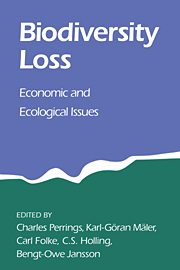Book contents
- Frontmatter
- Contents
- Foreword
- Preface
- List of contributors
- Introduction: framing the problem of biodiversity loss
- PART I CONCEPTUALISING DIVERSITY AND ECOSYSTEM FUNCTIONS
- 1 Diversity functions
- 2 Biodiversity in the functioning of ecosystems: an ecological synthesis
- 3 Scale and biodiversity in coastal and estuarine ecosystems
- PART II INTEGRATING ECOLOGY AND ECONOMICS IN THE ANALYSIS OF BIODIVERSITY LOSS
- PART III ECONOMIC ISSUES
- PART IV CONCLUSIONS
- References
- Index
2 - Biodiversity in the functioning of ecosystems: an ecological synthesis
Published online by Cambridge University Press: 05 June 2012
- Frontmatter
- Contents
- Foreword
- Preface
- List of contributors
- Introduction: framing the problem of biodiversity loss
- PART I CONCEPTUALISING DIVERSITY AND ECOSYSTEM FUNCTIONS
- 1 Diversity functions
- 2 Biodiversity in the functioning of ecosystems: an ecological synthesis
- 3 Scale and biodiversity in coastal and estuarine ecosystems
- PART II INTEGRATING ECOLOGY AND ECONOMICS IN THE ANALYSIS OF BIODIVERSITY LOSS
- PART III ECONOMIC ISSUES
- PART IV CONCLUSIONS
- References
- Index
Summary
Introduction
Analyses of biodiversity typically revolve around four questions, two of which are generally characterised as questions in ecology, and two as questions in economics. They are:
How do natural processes and human actions affect the number and persistence of species?
What different roles does biodiversity serve in determining the structure and function of ecosystems?
What are the social and economic driving forces that generate human impacts on biodiversity?
What is the value of biodiversity for human agricultural, ethical, medical, renewable resource and social purposes?
This chapter is written by ecologists for nonecologists – and primarily for economists. In one sense it is a primer describing our present state of understanding of ecosystems, the way they are structured, the way they function and the way they respond to disturbance and human management. In doing so, we concentrate on the first two questions. We attempt to do so in such a way that nonecologists can recognise concepts, explanations and descriptions that, if included in linked economic/ecological models and analyses, would produce an understanding of the problem that would be more consonant with present knowledge of the way ecosystems are structured and function.
Because the remaining two topics are the consequence of social, institutional and economic systems, we will leave those to our economist colleagues in the hope that they, in turn, will educate us in understanding how human dynamics intersect with nature.
- Type
- Chapter
- Information
- Biodiversity LossEconomic and Ecological Issues, pp. 44 - 83Publisher: Cambridge University PressPrint publication year: 1995
- 165
- Cited by



